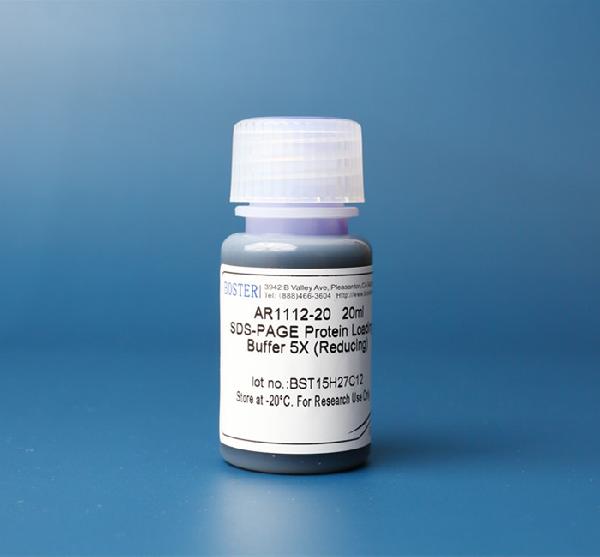Product Info Summary
| SKU: | BA1054 |
|---|---|
| Size: | 0.5ml |
| Reactive Species: | Rabbit |
| Host: | Goat |
| Application: | ELISA, WB |
Customers Who Bought This Also Bought
Product info
Product Overview
| Product Name | HRP Conjugated AffiniPure Goat Anti-Rabbit IgG (H+L) |
|---|---|
| Synonyms | HRP-conjugated goat anti-rabbit IgG |
| Description | Goat Anti-Rabbit IgG (H+L) Secondary Antibody, HRP Conjugate, for the indirect sensitive immunodetection and/or quantification of target proteins through WB, or ELISA by assaying an HRP-catalyzed reaction product in the vicinity of the antigen-primary antibody-secondary antibody-HRP complex. |
| Reagent Type | Secondary antibody, reporter enzyme labeled |
| Label | HRP (Horseradish Peroxidase) |
| Host | Goat |
| Target Species | Rabbit |
| Antibody Class | IgG |
| Clonality | Polyclonal |
| Immunogen | Rabbit IgG (whole molecular) |
| Purification | The antibody was purified from antisera by immunoaffinity chromatography. |
| Specificity | This HRP conjugated antibody is specific for rabbit IgG and shows no cross-reactivity with mouse/bovine IgG. |
| Form Supplied | Concentrated, Liquid |
| Formulation | 0.5 mg of HRP conjugated specific antibody
0.01 M PBS (PH 7.4) 50% glycerol |
| Pack Size | 0.5 ml |
| Concentration | 1mg/ml |
| Application | ELISA*, WB* *Our Boster Guarantee covers the use of this product in the above marked tested applications. |
| Storage | At -20˚C for one year from date of receipt. Avoid repeated freezing and thawing. |
| Precautions | FOR RESEARCH USE ONLY. NOT FOR DIAGNOSTIC OR CLINICAL USE |
Assay Information
| Sample Type | SDS-PAGE separated-, membrane-immobilized-, mouse primary-antibody-probed proteins from cell/tissue lysates |
|---|---|
| Assay Type | Immunoassay |
| Assay Purpose | Protein detection/quantification |
| Technique | Immunodetection of target antibody with HRP reporter enzyme |
| Equipment Needed | WB/ELISA instrumentation; X-ray film cassette or a charge-coupled device (CCD) imager; Spectrophotometer |
| Compatibility with Reagents | Incompatible with sodium azide and metals incompatible with high phosphate concentrations |
Main Advantages
| Specific | High signal-to-noise ratio |
|---|---|
| Sensitive | Detects low-abundant targets due to an optimal number of HRP molecules per antibody |
| High Signal Amplification | Multiple secondary antibodies can bind to a single primary antibody;Secondary antibodies Fc regions provide further binding locations for biotin, or enable the use of ABC and SABC |
| Fast | Generates strong signals in a relatively short time span |
| Quantifieable | Allows quantification of detected signal |
| Easy to Use | Supplied in a workable liquid format |
| Flexible | HRP: compatible with chromogenic, fluorogenic and chemiluminescent substrates; |
| Convenient | HRP’s small size: no interference with the primary/secondary antibody interaction; no steric hindrance to antibody/antigen complexes |
Background
Most commonly, secondary antibodies are generated by immunizing the host animal with a pooled population of immunoglobulins from the target species. The host antiserum is then purified through immunoaffinity chromatography to remove all host serum proteins, except the specific antibody of interest, and are then modified with antibody fragmentation, label conjugation, etc. Secondary antibodies can be conjugated to a large number of labels, including enzymes, biotin, and fluorescent dyes/proteins. Here, the antibody provides the specificity to locate the protein of interest, and the label generates a detectable signal. The label of choice depends upon the experimental application.
Horseradish peroxidase (HRP) is extensively used for labeling secondary antibodies in ELISA, western blot, dot blot and immunohistochemistry. The HRP enzyme is made visible using a substrate that, when oxidized by HRP in the presence of hydrogen peroxide as an oxidizing agent, yields a characteristic change that is detectable by specific detection methods. The substrates commonly used with HRP fall into different categories including chromogenic, fluorogenic, and chemiluminescent substrates depending on whether they produce a colored, fluorimetric or luminescent derivative respectively. The intensity of the signal is proportional to peroxidase activity and is a measure of the number of enzyme molecules reacting, hence of the amount of recognized primary antibodies, and thus of the amount of target antigen.
Product Images
Assay Dilutions Recommendation
The recommendations below provide a starting point for assay optimization. Actual working concentration varies and should be decided by the user.
Western Blotting: 0.1-0.2μg/ml (ECL detection)
Western Blotting: 0.7-3.3μg/ml (DAB detection)
ELISA: 0.05-0.5μg/ml (TMB detection)
Validation Images & Assay Conditions

Click image to see more details
Specific Publications For BA1054
Hello CJ!
BA1054 has been cited in 1459 publications:
*The publications in this section are manually curated by our staff scientists. They may differ from Bioz's machine gathered results. Both are accurate. If you find a publication citing this product but is missing from this list, please let us know we will issue you a thank-you coupon.
Upregulation of ATG4A promotes osteosarcoma cell epithelial-to-mesenchymal transition through the Notch signaling pathway
Exosomes secreted by HUVECs attenuate hypoxia/reoxygenation-induced apoptosis in neural cells by suppressing miR-21-3p
MiR-514a-3p inhibits cell proliferation and epithelial-mesenchymal transition by targeting EGFR in clear cell renal cell carcinoma
Hypoxia promotes epithelial-mesenchymal transition of hepatocellular carcinoma cells via inducing Twist1 expression.
Nogo-A antibody treatment enhances neuron recovery after sciatic nerve transection in rats.
Calpain 1 regulates TGF-β1-induced epithelial-mesenchymal transition in human lung epithelial cells via PI3K/Akt signaling pathway
ERK/CANP rapid signaling mediates 17β-estradiol-induced proliferation of human breast cancer cell line MCF-7 cells
Protective mechanism of kaempferol against Aβ25-35-mediated apoptosis of pheochromocytoma (PC-12) cells through the ER/ERK/MAPK signalling pathway
Inhibition of proliferation, migration and invasion of human non-small cell lung cancer cell line A549 by phlomisoside F from Phlomis younghusbandii Mukerjee
Glucagon-like peptide-1/glucose-dependent insulinotropic polypeptide dual receptor agonist DA-CH5 is superior to exendin-4 in protecting neurons in the 6-hydroxydopamine rat Parkinson model
Customer Reviews
Have you used HRP Conjugated AffiniPure Goat Anti-Rabbit IgG (H+L)?
Submit a review and receive an Amazon gift card.
- $30 for a review with an image
0 Reviews For HRP Conjugated AffiniPure Goat Anti-Rabbit IgG (H+L)
Customer Q&As
Have a question?
Find answers in Q&As, reviews.
Can't find your answer?
Submit your question
2 Customer Q&As for HRP Conjugated AffiniPure Goat Anti-Rabbit IgG (H+L)
Question
Would either BA1054 or BA1003 secondary antibody work for M00139 for flow cytometry?
Verified customer
Asked: 2019-11-25
Answer
We don't recommend the Goat Anti-Rabbit IgG (H+L) Secondary Antibody, HRP Conjugate (BA1054) and Goat Anti-Rabbit IgG (H+L) Secondary Antibody, Biotin Conjugate (BA1003) for M00139 for flow cytometry.
Boster Scientific Support
Answered: 2019-11-25
Question
What type of concentration and the state of the preservatives was used for the BA1054 secondary antibody? Is it liquid or lyophilized?
Verified customer
Asked: 2019-10-29
Answer
The Goat Anti-Rabbit IgG (H+L) Secondary Antibody, HRP Conjugate BA1054 is concentrated, Liquid with a concentration of 1 mg/ml. The contents are as followed: 0.5 mg of peroxidase conjugated specific antibody, 0.01 M PBS (pH7.4), 50% glycerol.
Boster Scientific Support
Answered: 2019-10-29






